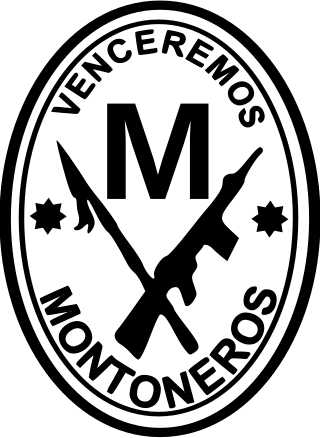
Montoneros was an Argentine far-left Peronist and Catholic revolutionary guerrilla organization, which emerged in the 1970s during the "Argentine Revolution" dictatorship. Its name was a reference to the 19th-century cavalry militias called Montoneras, which fought for the Federalist Party in the Argentine civil wars. Radicalized by the political repression of anti-Peronist regimes, the influence of Cuban Revolution and socialist worker-priests committed to liberation theology, the Montoneros emerged from the 1960s Catholic revolutionary guerilla Comando Camilo Torres as a "national liberation movement", and became a convergence of revolutionary Peronism, Guevarism, and the revolutionary Catholicism of Juan García Elorrio shaped by Camilism. They fought for the return of Juan Perón to Argentina and the establishment of "Christian national socialism", based on 'indigenous' Argentinian and Catholic socialism, seen as the ultimate conclusion of Peronist doctrine.

Isabel Martínez de Perón is an Argentine former politician who served as the 46th President of Argentina from 1974 to 1976. She was one of the first female republican heads of state in the world, and the first woman to serve as president of a country. Perón was the third wife of President Juan Perón. During her husband's third term as president from 1973 to 1974, she served as both the 29th Vice President and First Lady of Argentina. From 1974 until her resignation in 1985, she was also the 2nd President of the Justicialist Party.
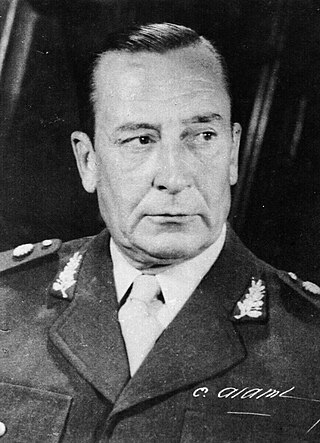
Pedro Eugenio Aramburu Silveti was an Argentine Army general who was the dictator of Argentina from November 13, 1955, to May 1, 1958. He was a major figure behind the Revolución Libertadora, the military coup against Juan Perón in 1955. He was kidnapped by the left-wing organization Montoneros on May 29, 1970, and then murdered as part of retaliation. He had been involved in the June 1956 execution of Army General Juan José Valle—associated with the Peronist movement— and 26 Peronist militants, after a botched attempt to overthrow his regime.

The People's Revolutionary Army was the military branch of the communist Workers' Revolutionary Party in Argentina.
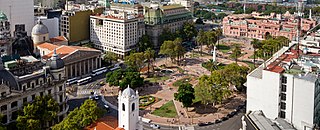
The Plaza de Mayo is a city square and the main foundational site of Buenos Aires, Argentina. It was formed in 1884 after the demolition of the Recova building, unifying the city's Plaza Mayor and Plaza de Armas, by that time known as Plaza de la Victoria and Plaza 25 de Mayo, respectively. The city centre of Buenos Aires, Plaza de Mayo has been the scene of the most momentous events in Argentine history, as well as the largest popular demonstrations in the country. On the occasion of the first anniversary of the May Revolution in 1811, the Pirámide de Mayo was inaugurated in the square's hub, becoming Buenos Aires' first national monument.

The Casa Rosada, literally the Pink House, is the president of the Argentine Republic's official workplace, located in Buenos Aires. The palatial mansion is known officially as Casa de Gobierno. Normally, the president lives at the Quinta de Olivos, the president of Argentina's official residence, located in Olivos, Greater Buenos Aires. The characteristic color of the Casa Rosada is baby pink, and it is considered one of the most emblematic buildings in Buenos Aires. The building also houses a museum, which contains objects relating to former presidents of Argentina. It has been declared a National Historic Monument of Argentina.
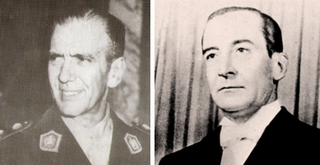
Revolución Libertadora was the coup d'état that ended the second presidential term of Juan Perón in Argentina, on 16 September 1955.

José López Rega was an Argentine politician who served as Minister of Social Welfare from 1973 to 1975, first under Juan Perón and continuing under Isabel Perón, Juan Perón's third wife and presidential successor. Lopez Rega exercised an allegedly Rasputin-like power and influence over Isabel Perón during her presidency, and used both this and his unique access to become the de facto political boss of Argentina. His orthodox peronist and far-right politics and interest in occultism earned him the nickname El Brujo. López Rega had one daughter, Norma Beatriz, who went on to become the spouse of President Raúl Lastiri.

The bombing of Plaza de Mayo was a massacre in Buenos Aires, Argentina, on 16 June 1955. Thirty aircraft from the Argentine Navy and Air Force bombed and strafed Plaza de Mayo. The attack targeted the adjacent Casa Rosada, the seat of government, while a large crowd demonstrated in support of the president, Juan Perón. The strike took place during a day of official public demonstrations to condemn the burning of a national flag allegedly carried out by detractors of Perón during the recent Corpus Christi procession. The military reacted as a result of growing tension between Perón and his actions against the Roman Catholic Church. The action was to be the first step in an eventually aborted coup d'état. The number of identified bodies was put at 308, including six children, making it the deadliest terrorist attack in Argentine history. Some victims could not be identified.
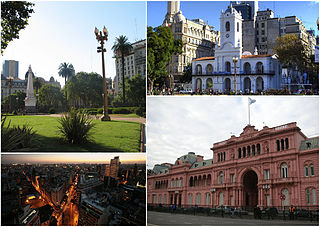
Monserrat or Montserrat is a neighbourhood in the east of the Buenos Aires CBD. The district features some of the most important public buildings in Buenos Aires, including city hall, the city legislature, Casa Rosada, the Colegio Nacional de Buenos Aires and the Libertador Building, among others.
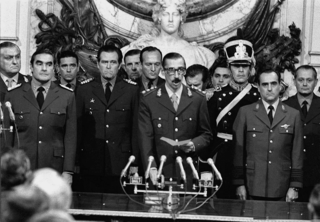
The 1976 Argentine coup d'état overthrew Isabel Perón as President of Argentina on 24 March 1976. A military junta was installed to replace her; this was headed by Lieutenant General Jorge Rafael Videla, Admiral Emilio Eduardo Massera and Brigadier-General Orlando Ramón Agosti. The political process initiated on 24 March 1976 took the official name of "National Reorganization Process", and the junta, although not with its original members, remained in power until the return to the democratic process on 10 December 1983. The coup was planned and executed within the framework of Operation Condor, a clandestine system of coordination between Latin American countries promoted by the United States, as part of the national security doctrine, which generalized dictatorships in Latin America in order to maintain stability in those countries during the Cold War and avoid something worse, according to U.S. justifications.

Argentine Revolution was the name given by its leaders to a military coup d'état which overthrew the government of Argentina in June 1966 and began a period of military dictatorship by a junta from then until 1973.
There are many landmarks in Buenos Aires, Argentina, some of which are of considerable historical or artistic interest.

The Argentine legislative elections of 1962 was held on 18 March. Voters chose their legislators and governors; with a turnout of 85.7%.

The Quinta presidencial de Olivos, also known as Quinta de Olivos, is an architectural landmark in the north side Buenos Aires suburb of Olivos and the official residence of the president of Argentina. It is one of the president's official residences.
The expulsion of Montoneros from Plaza de Mayo was a key event of the third presidency of Juan Perón. It took place on May 1, 1974, during celebrations of International Workers' Day.
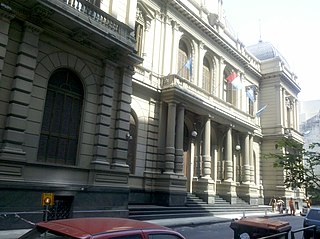
The Headquarters of the Provincial Bank of Córdoba, more often referred locally as Banco de Córdoba Casa Central, is a large bank building in Córdoba, Argentina.

The Ministry of Social Development was a ministry of the Argentine Government which oversaw the country's public policies on issues such as social assistance, welfare and human development across the country. The ministry was created in 1955 as the Ministry of Social Assistance, and it was given its current name in 1999 during the presidency of Fernando de la Rúa.

The Edificio de la Comandancia en Jefe de la Armada de Chile, also known as Edificio de la Intendencia de Valparaíso, because it was a purpose-built Intendencia, is a building designed in an eclectic style with Renaissance Revival architecture elements, which rises 5 floors in height and covers 8,000 square metres (86,000 sq ft). The main facade of the building faces the Plaza Sotomayor of Valparaíso and the Monument to the Heroes of Iquique.

Unzué Palace, also known as Quinta Unzué, was the presidential residence of the Argentine Republic located in Buenos Aires during the presidency of Juan Domingo Perón (1946–1955), and became a place of pilgrimage and cult after the death of Eva Perón in 1952. The building's symbolic importance was such that, after the military coup that led to Perón's downfall in 1955, the dictators who subsequently took power ordered its complete demolition, to erase all traces of its former occupants.






















